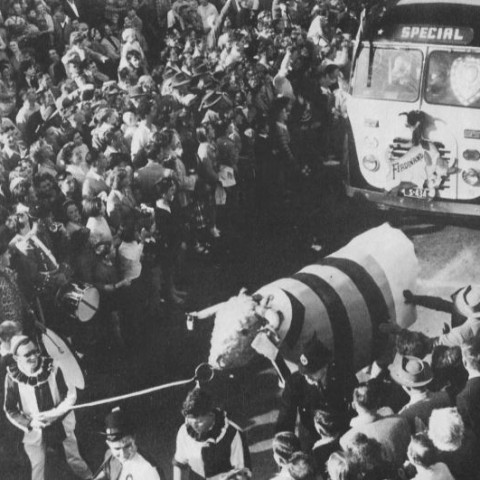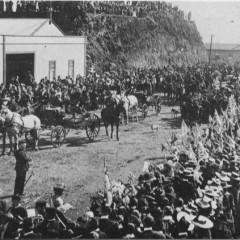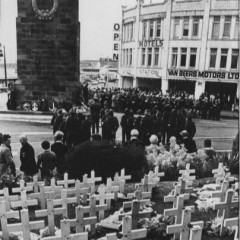15:3
Other hotels which had comparatively brief but noteworthy careers included the Windsor Castle in Bulteel Street, built for Frederick Windsor in the late 1850s. This hotel, which was a two-storey building containing 13 rooms in addition to the 'usual offices', found great favour with the troops stationed in the nearby Marsland Hill barracks, as did the Masonic Hotel. When in the 1880s the Windsor Castle was closed, it was 'removed holus bolus from BuIteel Street . . . was lifted bodily, chimneys and all, put on a huge wheeled contraption and tugged per bullocks assisted by men with jacks' . It was dragged down Dawson and Powderham Streets, with old cannon balls being occasionally used as rollers, to its new site near the present YWCA building. Until 1916, when it was destroyed by fire, it served as a boarding house under the name Chatsworth House. A concrete building was erected in its place which was later named Clark Memorial Building as a monument to James Clark, Mayor from 1919 to 1920, who was killed in an aeroplane crash near the racecourse. In 1921 it became the YWCA hostel, a purpose it served until the present hostel was built nearby, when it was converted into commercial offices. The memorial lettering was painted over, but in 1980 it was still faintly discernible. The Commercial Hotel on the corner of Brougham and Vivian Streets served variously as a boarding house, a tavern, a military barracks, a band hall and a billiards room until it was demolished in 1888. The Albion Hotel on the corner of Robe and Vivian Streets was advertised in the Taranaki Herald in 1856 as a 'hotel and family boarding house' until it was destroyed by fire in November, 1867. In Gill Street a sign over the door to premises occupied by the Farmers Co-operative Organisation reads Hotel Cargill. This was a private hotel built in 1935 and was one of several such institutions which gave admirable service to visitors and itinerant workers. Many of them were closed down as fire prevention measures became more stringent, and motels took their place. In 1980 there were more than 20 motels in the town, and it was partly their competition in the cheaper accommodation field which forced the breweries to build similar style one-floor motor-type hotels.
There have been at least three gentlemen's clubs in New Plymouth. The first was opened on August 15, 1842, in a cob house built by Samuel Fishleigh, 'a farmer, of New Plymouth', for John George Cooke, James Webster and John Tylston Wicksteed, as 'trustees for a society or club called the Taranaki Club' on the south-west corner of Brougham and Devon Streets. It was described in the lease agreement as 'a messuage or tenement situation in Devon Street, built of cob and roofed with shingles-yeilding and paying to the said Samuel Fishleigh thirty-six pounds sterling ($72) annually, in two equal half-yearly payments, whereof the first will become due on the fifteenth of February, 1843'. It was also agreed that subject to certain conditions 'the tenancy is to continue for another year, and so on from year to year'. There is no record of membership of this club, or when it closed, but on January 1, 1861 another Taranaki Club was opened' in Mr Hoskins' large room at the weekly rental of two pounds sterling weekly'. A list of 52 founding members, whose names were printed in a four-page booklet of 'Rules of the Taranaki Club'!" by G. W. Woon, of the Herald office, included J. H. and H. Richmond, H. A. Atkinson, W. Carrington, Archdeacon Govett, the Rev. H. H. Brown, O. Carrington, W. H. Skinner, W. Hursthouse and several military officers. The rules stipulated that the club hours should be between 10 a.m. and 10 p.m.; entrance fee 'ten shillings ($1) and quarterly subscription fifteen shillings ($1.50) payable in advance', there would be refreshments 'such as biscuits, cheese, beer, wine and spirits, etc .
No game of hazard shall, on any account, be played in the room, nor shall cards or other games be allowed on Sundays ... no higher stake than one shilling shall be played for, nor more than this sum betted.' There was to be no smoking in the library, and' anyone lighting a cigar or a pipe in the main club room from a candle' faced a fine of sixpence. In January, 1862, Mr Hoskins' room was too small, and the club conducted its business in 'Mr Black's Room except when Freemasons required it' .There was growing dissatisfaction with this arrangement and when no other suitable premises could be found a proposal to wind up the club was carried at the last recorded meeting on March 23, 1865. The third, and present, Taranaki Club was founded on August 4, 1892, when a meeting of' gentlemen interested in forming a club' was held in a building in Egmont Street leased for two years from J. G. George. Twenty-three prominent townspeople, including Oliver Samuel, Dr Leatham, Henry Govett and J. B. Roy, attended. Samuel was elected president. Rules were drawn up; subscriptions were three guineas a year for town and two guineas for country members.' J. F. Lepine was employed as steward at a wage of$4 a week. At that first meeting orders were placed for a billiards table, the supply of several prominent British and Australian periodicals, two gas stoves and three round tables for cards, and 'Mr A. E. A. Clarke's handsome gift of pictures' was accepted. Almost immediately the premises were found unsuitable to cater for the 106 members and by 1896 a search for alternative or improved premises began, which continued for the next 30 years. It was decided to build a one-storey clubhouse on the leased site; then a two-storey building; and plans were again altered to a single-storey structure. This was approved by the club, quotes were obtained, plans and specifica- tions drawn up, architects were commissioned and a mortgage arranged. At one of the many special general meetings the scheme was dropped; tenders were declined and all money returned-all, that is, except a firm of architects who were informed 'that as their plans have not proved to be within the conditions as to cost prescribed, no payment can be authorised. '20 A new and less expensive clubhouse had been built on the site by 1900, and although alterations and additions were made, it too proved unsuitable, and several sections in the town were examined as possible sites for a new freehold clubhouse. These included an area on Mount Eliot reserve; 'Mr Brooking's premises in Brougham Street; Mr S. W. Shaw's building fronting on King and Queen Streets;' Chatsworth House (the former Windsor Castle Hotel which had been moved from Bulteel Street to Powderham Street), and 'Mrs Berry's site on the corner of St Aubyn Street and Queen Street.'
This was bought in 1919 for $5150 in spite of a resolution that not more than $4000 should be paid for it. 21 In the meantime the club's lease on the old clubhouse had been sold to Hookers Transport. A billiards room had been added; the building had been linked up to the town's drainage and sewerage system (before 1911 the night-cart and the Mangaotukti Stream which flowed past the back of the clubhouse served this purpose) and better facilities had been provided for its increasing membership. The minutes reveal something of the problems faced by the committee at the turn of the century.
High on each agenda was the question of buying a tea urn to replace the steward's service of providing tea at 10c a cup; there were umbrella stands, extra spittoons, a combined aneroid thermometer and barometer to be bought; there were annual exhibitions by such champions as Walter Lindrum and Clark McConachie, for which they received a fee of$21, to be arranged. And the price of liquor was a frequent cause of controversy: in 1915 Dewar's Whisky was bought for 'twenty-one shillings ($2.20) a gallon and resold to members at seven and sixpence (75c) a bottle'.
In 1921 A. B. Burrell's tender to erect the new building for $20,600 was accepted and official authority was received provided that 'no New Zealand cement was used'; the site was cleared of all buildings except a cottage which had been built in 1885 and which, in 1980 was still used as the manager-secretary's residence. On August 17, 1922, the new club premises were opened at a special function, followed by a ball attended by presidents of all other Taranaki clubs and their wives, and most of the notables from the town. Alterations and improvements continued and in 1980 there were three billiard tables, two large lounges, a restaurant, card rooms and a spacious bar to cater for the 430 members. Among the heirlooms in the club are some of the original circular card tables, and a set of bound volumes of Punch from 1841 to 1929. The old building in Egmont Street was used for a time by Hookers as offices for social services and a variety of other purposes until it was taken over by the Returned Services Association. Class distinction was a fact of life in the early years of settlement, and not everyone was eligible or indeed would have felt comfortable in a gentlemen's club. On June 26, 1853, the Taranaki Herald referred to a 'men's club in King's Rooms, where music, singing, whist and chess is played.' Subsequent records of this club, and so many other early establishments, have been lost, but the Taranaki Almanac and Official Directory of 1904 notes there was 'The New Plymouth Working Men's Club' of which Joseph Bird was president and R. Snell secretary and treasurer. The present New Plymouth Club was established in August 1908. President was Gustave Tisch, the Mayor, and early meetings were held in the second floor of a building where the present Mayfair Theatre stands. The rules stipulated that all men were eligible except those under the age of 21, or men who had been expelled from other clubs or had been convicted of a criminal offence, drunkenness or bookmaking. The objects of the club were 'to pro- mote the moral, social and intellectual interests of the members and to offer facilities for mutual improvement and pleasant social inter- course.' In 1955 new premises were erected on the site of the old Foresters' Hall in Gill Street, and these were enlarged and refurnished in 1973 at a cost of $191,000. Present facilities for its 1600 men and 129 women members include four billiard tables, a large lounge, a bar and a restaurant. Among long-serving officers were L. Humphries, secretary from 1916 to 1951; J. W. T. Murphy, secretary between 1960 and 1978; and 1. Muir Thomson, president from 1956 to 1962. Club affairs have not always run smoothly. On May 2, 1958, the club was accused, following a police raid, of selling liquor without a proper licence; 70 members were charged with being illegally on the club's premises, and liquor to the value of $392 was seized. Convictions were. entered and four months later, on appeal, Mr Justic
Gresson, in a reserved judgment, found that the search warrant to enter the premises was 'invalid and improperly issued' and suggested that the court should refuse to make an order for the forfeiture of the liquor as the seizure was made without proper authority. The magis- trate withdrew all charges, and the liquor was returned. Cost to the club of police proceedings was $216.16, which was not recovered. In 1960 a charter to sell liquor was obtained to replace the locker system which had been in operation since the club was formed. The nation's business returned to normal following World War Two, New Plymouth commercial travellers saw the need for a club in which they, and their visiting counterparts, could meet in friendly social surroundings. At a meeting in the Criterion Hotel on May 1, 1945, the Taranaki Commercial Travellers' and Warehousemen's Association was formed. Meetings were held on Friday nights in the old Masonic Hall, Robe Street, until in 1951 an old house in Robe Street opposite the courthouse was bought for $4000, modified and repaired, and opened in December, 1952. This served the club's purposes in rather cramped conditions until nearby property was bought, the old clubrooms demolished, and a new two-storey building erected on the site and opened in July, 1972. The club has organised annual Christmas parties and parcels for the hospital, and by 1980 had contributed more than $50,000 to various charities. The New Plymouth Women's Club was founded in July, 1926. Its first president was Mrs F. E. Wilson, Mayoress. Its objects were to provide a centre for women interested in social, public, scientific and artistic affairs, and its motto was 'friendliness'.
For many years meetings were held in members' homes, and it was not until 1950 that the present premises in Powderham Street were bought, converted into clubrooms and officially opened in 1952. In 1980 there were 187 members; the club hours were II a.m. to 4 p.m. on four days a week. Main activities were Mah-Jongg, bridge and a gardening circle. The New Plymouth Senior Citizens' Association began as the founding branch of the New Zealand Old Folks' Association in 1941. It changed its name in 1969. Founder and first president was A. H. Vile who, with support from the Mayor, E. R. C. Gilmour, and many service clubs, Toe H, and other organisations, was instrumental in procuring a club room in Currie Street. Objects of the association were 'to brighten the declining years of men and women who are over the age of 60 years'. By the time Mr and Mrs Vile left New Plymouth to live at Hastings the following year, membership had grown from 250 to 700, and other branches had been formed in many cities and towns in the country. Soon the premises grew too small, and following a vigorous drive for funds a larger assembly hall was built in Liardet Street in 1947. This was destroyed by fire following a dance on November 31, 1965, causing damage estimated at $30,000. The Taranaki Herald immediately launched an appeal to restore and enlarge the building and a year later, a new complex, valued at $42,000, was opened by the MP for New Plymouth, E. P. Aderman. The present adjoining hall was opened by A. P. D. Friedlander, MP, when membership had grown to more than 900.


